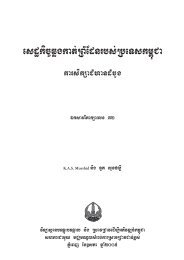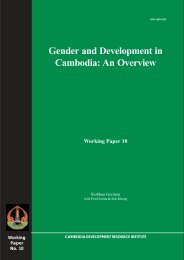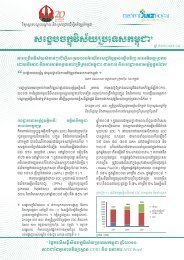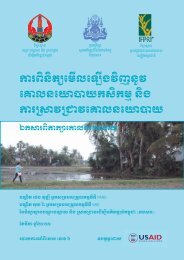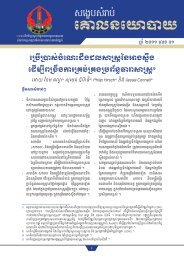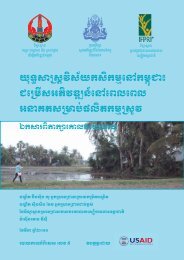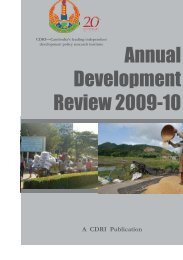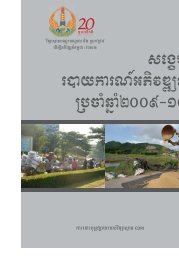Cambodia Country Study Working Paper Series No. 44 ... - CDRI
Cambodia Country Study Working Paper Series No. 44 ... - CDRI
Cambodia Country Study Working Paper Series No. 44 ... - CDRI
You also want an ePaper? Increase the reach of your titles
YUMPU automatically turns print PDFs into web optimized ePapers that Google loves.
��������������������������������������������������������������������������������������<br />
������ ������ ����� ��� ����� ��� ����� ���������� ��� ��������� ��������� �������� ����� �����<br />
available in the village or nearby, even if they paid only 8000 riels per day, but the<br />
�����������������������������������������������������������������������������������������<br />
����������������������������������������������������������������������������������������<br />
the <strong>Cambodia</strong>n government to negotiate with the Thai government to allow <strong>Cambodia</strong>ns<br />
to work in Thailand on a lower cost permit. He believed that if the work permit cost only<br />
150,000 riels and the renewal 100,000 riels, people would be willing to work legally so<br />
that they were protected and free from exploitation.<br />
Source: interview, September 2007<br />
3.2.6. Remittances<br />
Remittances are one of the most important variables of the study. They are basically what<br />
������������������������������������������������������������������������������������������<br />
First, people may not reveal the true amount because they tend to hide their income.<br />
Second, they may forget, especially if the last remittance was months or years ago. Third,<br />
remittance over what time frame—some migrants keep going back to work near the border,<br />
while some returned home only after a year and did not migrate again in the previous two<br />
years. Fourth, some might return soon with their savings, but respondents at home did not<br />
know for sure. We tried to address these challenges by interviewing respondents in the<br />
����������������������������������������������������������������������������������������������<br />
year and for the most recent trip.<br />
�������������������������������������������������������������������������������������<br />
make remittances. They go to work for a few weeks to a few months and then come home<br />
�����������������������������������������������������������������������������������������<br />
��������������������������������������������������������������������������������������<br />
For those working in areas near the border, it is a case of “low risk, low return”.<br />
However, not everyone working deep inside Thailand sent money home. Overall, only 73<br />
percent of these migrant had sent remittances in the past year. The highest proportion (91<br />
percent) of migrants sending remittances are in housework. The smallest proportion are<br />
in agricultural work far from the border; 11 of 27 migrants doing this work were reported<br />
as sending no money home. This could be due to the fact that they will bring their savings<br />
�����������������������������������������������������������������������������������������<br />
��������������������������������������������������������������������������<br />
Of course, the amount of remittance varies depending on the work migrants do and for<br />
��������������������������������������������������������������������������������������<br />
from the border, sent home or came back with USD30–84 for the last trip, which lasted<br />
�������� �� ���� ������ ���� �� ���� �������� ��������� ���� ����� ����� ���������������� ����<br />
stayed longer for each trip remitted USD150–180 for the last trip. <strong>No</strong>te that the remittance<br />
is not the total earning of migrants but the net saving after their living expenses.<br />
<strong>CDRI</strong><br />
32



